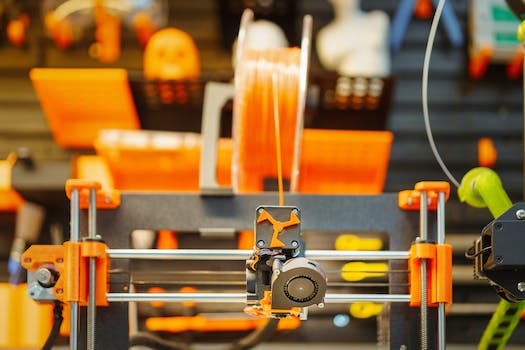
The Impact of 3D Printing on Manufacturing and Design
-
Table of Contents
- Introduction
- Exploring the Benefits of 3D Printing for Manufacturing and Design
- How 3D Printing is Revolutionizing the Manufacturing Industry
- The Impact of 3D Printing on Product Design and Development
- The Future of 3D Printing in Manufacturing and Design
- Examining the Cost Savings of 3D Printing for Manufacturing and Design
- Q&A
- Conclusion
“Unlock the Possibilities of 3D Printing: Transform Manufacturing and Design for the Future!”
Introduction
The 3D printing revolution has been a game-changer for the manufacturing and design industries. It has enabled the production of complex parts and products with unprecedented speed and accuracy, and has opened up new possibilities for product design and customization. This article will explore the impact of 3D printing on manufacturing and design, and how it has revolutionized the way products are made and designed. We will look at the advantages and disadvantages of 3D printing, and how it has changed the way products are manufactured and designed. Finally, we will discuss the potential of 3D printing in the future and how it could shape the future of manufacturing and design.
Exploring the Benefits of 3D Printing for Manufacturing and Design
The world of manufacturing and design is rapidly changing, and 3D printing is at the forefront of this revolution. 3D printing, also known as additive manufacturing, is a process of creating three-dimensional objects from a digital file. This technology has been around for decades, but it has recently become more accessible and affordable, making it a viable option for businesses of all sizes.
The benefits of 3D printing for manufacturing and design are numerous. For starters, 3D printing can reduce the cost of production by eliminating the need for expensive tooling and molds. This can be especially beneficial for small businesses that don’t have the resources to invest in traditional manufacturing methods. Additionally, 3D printing can reduce lead times and increase production speed, allowing businesses to get products to market faster.
Another benefit of 3D printing is its ability to create complex designs that would be difficult or impossible to produce with traditional manufacturing methods. This can open up new possibilities for product design, allowing businesses to create unique and innovative products that stand out from the competition.
Finally, 3D printing can also reduce waste. Since the process is additive, only the material needed to create the object is used, eliminating the need for excess material. This can help businesses reduce their environmental impact and save money in the long run.
Overall, 3D printing is a powerful tool for manufacturing and design that can help businesses reduce costs, increase production speed, and create unique and innovative products. As the technology continues to evolve, it will become even more accessible and affordable, making it an even more attractive option for businesses of all sizes.
How 3D Printing is Revolutionizing the Manufacturing Industry
The manufacturing industry is undergoing a revolution, and 3D printing is at the forefront of this transformation. 3D printing, also known as additive manufacturing, is a process of creating three-dimensional objects from a digital file. This technology has been around for decades, but it has recently become more accessible and affordable, making it a viable option for many businesses.
3D printing offers a number of advantages over traditional manufacturing methods. It is faster, more efficient, and more cost-effective. It also allows for greater customization, as objects can be designed and printed to exact specifications. This makes it ideal for producing complex parts and components that would otherwise be difficult or impossible to create using traditional methods.
3D printing is also more environmentally friendly than traditional manufacturing. It requires less energy and produces less waste, making it a more sustainable option. Additionally, 3D printing can be used to create parts and components from recycled materials, further reducing its environmental impact.
Finally, 3D printing is revolutionizing the way products are designed and developed. It allows for rapid prototyping, which means that products can be tested and refined quickly and efficiently. This reduces the time and cost associated with product development, making it easier for businesses to bring new products to market.
The manufacturing industry is undergoing a major transformation, and 3D printing is playing a major role in this shift. It is faster, more efficient, and more cost-effective than traditional manufacturing methods, and it allows for greater customization and rapid prototyping. It is also more environmentally friendly, making it a more sustainable option. As 3D printing continues to evolve, it will no doubt continue to revolutionize the manufacturing industry.
The Impact of 3D Printing on Product Design and Development

The advent of 3D printing has revolutionized product design and development. This technology has enabled designers to create complex, intricate designs that would have been impossible to create using traditional manufacturing methods. It has also enabled them to quickly and easily prototype their designs, allowing them to test and refine them before committing to a full production run.
3D printing has made it easier for designers to create custom parts and components. This has allowed them to create products that are tailored to the specific needs of their customers. It has also enabled them to create products that are more efficient and cost-effective.
3D printing has also enabled designers to create products with complex geometries and intricate details. This has allowed them to create products that are more aesthetically pleasing and have a higher level of functionality.
Finally, 3D printing has enabled designers to create products faster and more efficiently. This has allowed them to reduce the time it takes to bring a product to market, allowing them to get their products to their customers faster.
Overall, 3D printing has had a profound impact on product design and development. It has enabled designers to create more complex, intricate designs, prototype their designs quickly and easily, create custom parts and components, and bring their products to market faster. This technology has revolutionized the way products are designed and developed, and it will continue to do so in the future.
The Future of 3D Printing in Manufacturing and Design
The future of 3D printing in manufacturing and design is an exciting prospect. With the technology advancing at a rapid pace, 3D printing is becoming increasingly accessible and affordable for businesses and individuals alike. This means that 3D printing is becoming a viable option for a wide range of applications, from prototyping to full-scale production.
3D printing has already revolutionized the way products are designed and manufactured. It has enabled companies to create complex parts and products with greater accuracy and speed than ever before. This has allowed them to reduce costs and increase efficiency.
In the future, 3D printing will become even more advanced. It will be used to create parts and products with greater complexity and precision. This will enable companies to create products that are more customized and tailored to their customers’ needs.
3D printing will also become more accessible. As the technology continues to improve, it will become more affordable and easier to use. This will open up the technology to a wider range of users, from hobbyists to professionals.
The future of 3D printing in manufacturing and design is an exciting one. As the technology continues to evolve, it will become more accessible and affordable, allowing businesses and individuals to create complex parts and products with greater accuracy and speed than ever before. This will open up a world of possibilities for businesses and individuals alike.
Examining the Cost Savings of 3D Printing for Manufacturing and Design
The cost savings of 3D printing for manufacturing and design are becoming increasingly apparent. As the technology continues to evolve, businesses are finding more and more ways to leverage 3D printing to reduce costs and increase efficiency.
3D printing is a process of creating three-dimensional objects from a digital file. It is a form of additive manufacturing, which means that objects are created by adding material layer by layer. This process is much faster and more cost-effective than traditional manufacturing methods, such as injection molding or machining.
One of the most significant cost savings of 3D printing is the elimination of tooling costs. With traditional manufacturing methods, tooling costs can be quite high. With 3D printing, however, the cost of tooling is eliminated, as the objects are created directly from the digital file. This can result in significant cost savings for businesses.
Another cost savings of 3D printing is the ability to produce complex designs quickly and easily. With traditional manufacturing methods, complex designs can be difficult and expensive to produce. With 3D printing, however, complex designs can be created quickly and easily, resulting in significant cost savings.
Finally, 3D printing can also reduce the cost of prototyping. With traditional manufacturing methods, prototyping can be expensive and time-consuming. With 3D printing, however, prototypes can be created quickly and easily, resulting in significant cost savings.
Overall, the cost savings of 3D printing for manufacturing and design are becoming increasingly apparent. As the technology continues to evolve, businesses are finding more and more ways to leverage 3D printing to reduce costs and increase efficiency.
Q&A
Q1: What is 3D printing?
A1: 3D printing is a process of creating three-dimensional objects from a digital file. It is also known as additive manufacturing, as it builds up objects layer by layer.
Q2: How does 3D printing impact manufacturing and design?
A2: 3D printing has revolutionized the way products are designed and manufactured. It has enabled faster prototyping, reduced costs, and improved product quality. It has also enabled the production of complex and customized products, which would have been impossible to manufacture using traditional methods.
Q3: What are the advantages of 3D printing?
A3: 3D printing offers several advantages, including faster prototyping, reduced costs, improved product quality, and the ability to produce complex and customized products. It also allows for shorter lead times and greater flexibility in production.
Q4: What are the disadvantages of 3D printing?
A4: 3D printing can be expensive and time-consuming. It also requires specialized knowledge and expertise to operate the machines. Additionally, 3D printed parts may not be as strong or durable as parts produced using traditional manufacturing methods.
Q5: What industries are using 3D printing?
A5: 3D printing is being used in a variety of industries, including automotive, aerospace, medical, and consumer products. It is also being used in the production of prototypes, tools, and molds.
Conclusion
In conclusion, 3D printing has had a significant impact on manufacturing and design. It has enabled companies to produce products faster, cheaper, and with greater accuracy. It has also allowed for the creation of complex designs that would have been impossible to create with traditional manufacturing methods. 3D printing has revolutionized the way products are designed and manufactured, and it is likely to continue to do so in the future.






